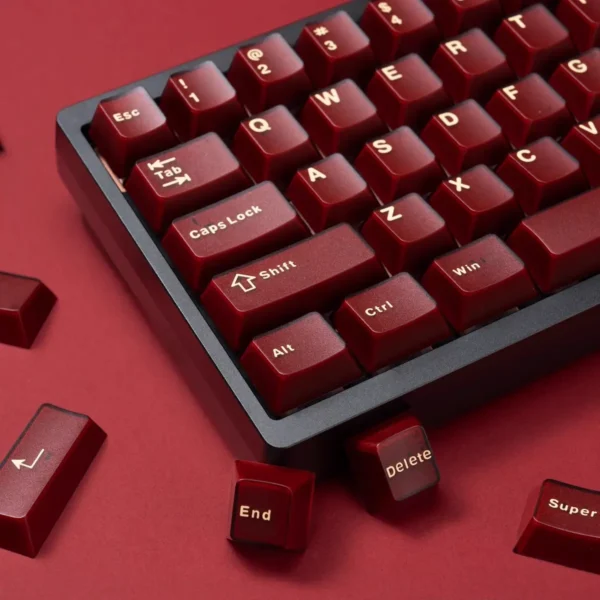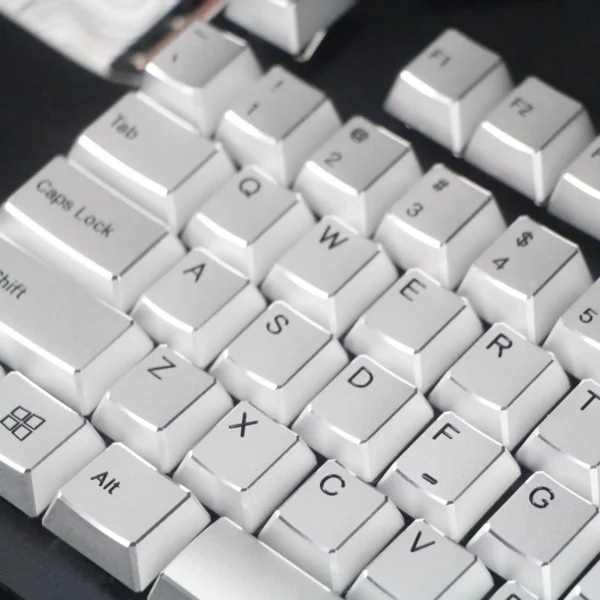A Guide to Comparing Keycap Profiles for Keyboards

Share:
Learn More:
A keycap profile is the shape and height of keycaps. It affects how comfortable typing feels and how well you can game. Sculpted profiles, like Cherry or OEM, have slanted angles to ease finger strain. Flat profiles, like DSA, have even surfaces for steady typing. Keycap profiles also change how a keyboard looks. Tall profiles, like SA, give a bold, old-fashioned style. Picking the right keycap profile depends on what you like and how you use your keyboard every day.
What Are Keycap Profiles?
Keycap profiles define the shape and height of your keyboard’s keycaps.
Different profiles feel different under your fingers. Some make typing easier, others are great for gaming, and a few just look cool on your desk.
Here’s why this matters:
• Comfort: Profiles like Cherry reduce finger strain over long hours.
• Speed: Low-profile caps make quick movements a breeze for gamers.
• Style: Retro profiles like SA stand out for custom keyboards.
Not all keycaps are created equal, so let’s dive into the details.

Sculpted vs Uniform Keycap Profiles
This is the big choice.
• Sculpted Profiles (Cherry, OEM, SA): Each row of keys has a different height and angle. It mimics the shape of your fingers, so typing feels natural.
• Uniform Profiles (DSA, XDA): Every key is the same height. This flat surface looks clean and modern, but it might feel less ergonomic for long sessions.
Here’s the quick comparison:
Type | Best For | Drawback |
Sculpted | Typing, reducing fatigue | Harder to rearrange keys |
Uniform | Clean designs, flexibility | Less finger comfort for some |
Why Keycap Profiles Matter
Keycap profiles can either make or break your typing or gaming setup.
- Comfort: Certain profiles match the curve of your fingers, making typing feel smooth and effortless.
- Speed: Profiles like Cherry are low and responsive, perfect for fast key presses during a competitive match.
- Aesthetics: Tall, bold profiles like SA scream retro, while low-profile keycaps give off modern minimalism.
The right profile depends on what you do most—type, game, or both.
Understanding Keycap Rows and Heights

Keyboards have rows labeled R1 to R4. Each row has a unique height and angle that shapes how the keycap profile feels.
- R1: The bottom row, usually the shortest.
- R2-R3: These middle rows have varying heights and angles for easy finger transitions.
- R4: The tallest row at the top, angled back for visibility and reach.
Some profiles, like Cherry or SA, are sculpted to follow this natural flow. Others, like DSA or XDA, keep all rows the same height, giving a flat, uniform feel.

Overview of Popular Keycap Profiles

Keycap Profiles at a Glance
- OEM: Standard height. Slightly sculpted. Great for beginners.
- Cherry: Lower than OEM, sculpted for comfort. Perfect for typing long hours.
- SA: Tall, vintage vibes. Bold aesthetics, but they take getting used to.
- DSA: Flat, low-profile. Sleek, simple, and ideal for gaming.
- XDA: Flat but with wider tops. Good for accuracy and custom designs.
- MDA: Flat, curved slightly for comfort. A nice mix of form and function.
- ASA: Modern-vintage hybrid. Stylish and comfortable for typing or gaming.
Each profile serves a unique purpose. Let’s dive deeper into each one.
OEM Keycap Profile
The OEM keycap profile is very common on mechanical keyboards. It has medium height and a slightly curved top. This makes it good for both typing and gaming. Each row has different heights and angles. This sculpted design helps guide your fingers easily.
OEM keycaps feel familiar and comfortable to use. The medium height balances comfort and function. It reduces finger tiredness during long typing. For gaming, the angled rows help press keys quickly without mistakes. They also look simple and professional, which many users like.
A big advantage of OEM keycaps is their availability. Many keyboards come with them, so replacements are easy to find. Some people may prefer taller profiles like SA or shorter ones like Cherry. Still, OEM keycaps are a practical and balanced choice for most users.
- Height: Medium.
- Shape: Slightly curved tops.
- Feel: Balanced for both typing and gaming.
- Pros: Familiar, widely available, and ergonomic.
- Cons: Lacks the flair of more custom profiles.
OEM is the “jack of all trades” of keycap profiles—good at everything but not exceptional in any one area.

Cherry Keycap Profile
The Cherry keycap profile is loved by those who want comfort and precision. It is low in height and has a sculpted shape. Each row has a specific height and angle. This design keeps hands in a natural position and reduces strain.
Cherry keycaps make typing smooth and fast. The low height means less finger movement, so you can type quicker. This is great for people who type or game for long hours. Gamers like Cherry keycaps because they are accurate and responsive during intense play.
Cherry keycaps also look modern and sleek. They match many keyboard styles, making them good for customization. Some may not like the low height if they want a stronger tactile feel. But its comfort and performance make it a favorite for many users.
- Height: Medium.
- Shape: Slightly curved tops.
- Feel: Balanced for both typing and gaming.
- Pros: Familiar, widely available, and ergonomic.
- Cons: Lacks the flair of more custom profiles.
If you’re into marathon gaming or typing sessions, Cherry profiles are a solid choice.

SA Keycap Profile
The SA keycap profile is tall and rounded, giving it a unique look. Each row has a different height and angle.
SA keycaps offer a special typing experience. The tall height and rounded tops need more finger movement. This feels satisfying for people who like pressing keys deliberately. Typists who lift their fingers high may find this profile comfortable. But it may not be ideal for fast gaming due to extra effort needed.
- Height: Super tall.
- Shape: Rounded tops with sculpted rows.
- Feel: Satisfying for deliberate typing but slow for gaming.
- Pros: Retro vibes and a distinctive feel.
- Cons: Not ideal for fast-paced work or gaming.
SA profiles are the showstoppers of keycaps, great for custom builds but less practical for daily grind.

DSA Keycap Profile
The DSA keycap profile is known for being flat and even. All rows are the same height, creating a smooth surface. This design is great for people who like simple keyboards. The low height makes pressing keys easy and reduces finger tiredness.
Typing on DSA keycaps feels steady and smooth. Fingers can move easily across the flat surface. But some may find it less comfortable than sculpted profiles like Cherry. For gaming, DSA keycaps give good control but less feedback than taller ones.
- Height: Low and flat.
- Shape: Even across all rows.
- Feel: Smooth and steady, with less strain from height differences.
- Pros: Perfect for custom layouts, clean look.
- Cons: Less ergonomic than sculpted profiles.
If you love simple designs and rearranging keys, DSA is for you.

XDA Keycap Profile
The XDA keycap profile is similar to DSA but slightly bigger. All rows are the same height, keeping the surface flat. The wider tops give more space for fingers, making typing easier.
Typing on XDA keycaps feels steady and precise. The flat design helps with consistent key presses, which many typists like. For gaming, XDA keycaps work well but lack the comfort of sculpted profiles like Cherry.
- Height: Slightly taller than DSA.
- Shape: Flat with wide tops.
- Feel: Roomy, steady, and easy to type on.
- Pros: Stylish and practical for custom keyboards.
- Cons: Lacks the comfort of sculpted profiles.
XDA profiles are a favorite for creative keyboard designs.

MDA Keycap Profile
The MDA keycap profile mixes flat and sculpted designs. It has medium height and slightly curved tops, making typing comfortable. Unlike DSA or XDA, MDA keycaps have small row differences for better ergonomics.
Typing on MDA keycaps feels natural and easy. The curved tops help guide fingers, reducing strain during long use. For gaming, MDA keycaps are both comfy and responsive, fitting casual and serious players.
- Height: Medium.
- Shape: Slightly curved for ergonomics.
- Feel: Comfortable, even for long sessions.
- Pros: Versatile and easy on the fingers.
- Cons: Might feel too plain for those who want bold features.
MDA profiles mix comfort and style, perfect for everyday use.

How to Choose the Best Keycap Profile
It’s all about your personal workflow and style.
Here are some quick tips:
- For Typing: Sculpted profiles like Cherry or OEM reduce strain and feel natural.
- For Gaming: Low-profile designs like Cherry or G20 are fast and responsive.
- For Style: Tall profiles like SA or flat ones like DSA make bold statements.
And don’t forget to experiment. Trying different profiles is the best way to find what feels right.

Where to Buy Keycaps with Unique Profiles
Here’s where I’ve found the best stuff:
- Drop: Amazing for premium profiles like SA, XDA, and DSA.
- KBDfans: Perfect for custom keyboard fans; their MDA keycaps are top-notch.
- KeycapMart: Cost-effective keycaps with many varieties.
- Amazon/MechanicalKeyboards.com: Affordable options for beginners.
Always check reviews before buying, especially if you’re diving into custom profiles.
And you can get more coupons at wethrift.
Conclusion
Keycap profiles change everything about how your keyboard feels and looks.
Cherry is your go-to for speed and comfort.
SA is the bold, retro champ.
DSA and XDA keep things sleek and simple.
And MDA or OEM? Perfect middle-ground options.
Whatever you pick, make sure it suits your daily grind—whether that’s gaming, typing, or just vibing with a cool setup.
FAQs
Customer Service / Support
What’s the most ergonomic keycap profile?
Cherry is the most ergonomic for most users, thanks to its low height and sculpted shape.
Are flat keycaps good for typing?
Yes, if you like a minimalist, uniform feel. DSA and XDA profiles are popular for steady typing.
Can you mix keycap profiles?
You can, but it might feel weird unless the heights are similar (e.g., MDA + ASA).
Are SA keycaps bad for gaming?
Not bad, but they’re not ideal. Their height slows down key presses.
Where should I start if I’m new to keycaps?
Go for OEM or Cherry—they’re beginner-friendly and widely available.




















